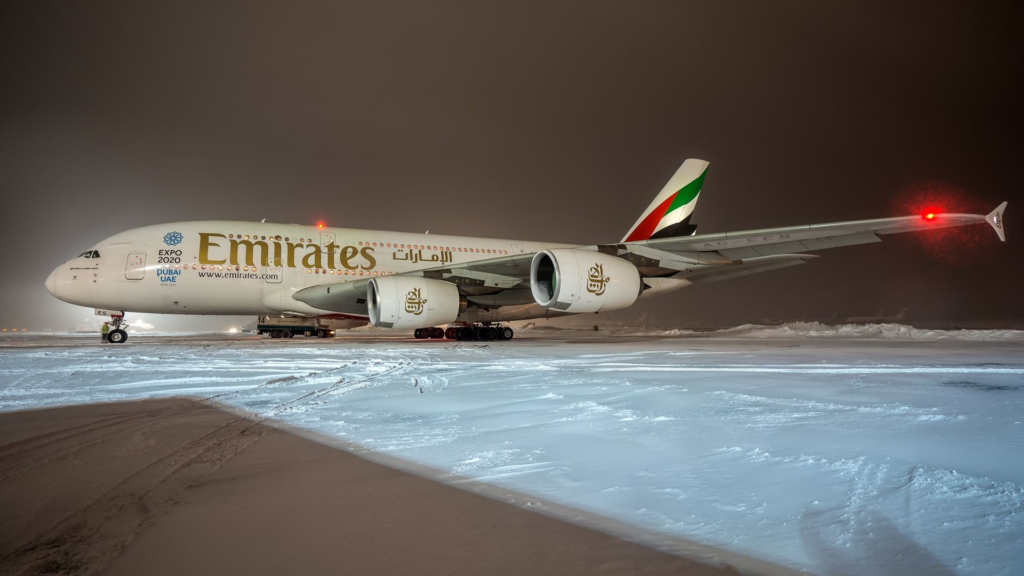Emirates is one of the few major airlines to operate an all-widebody fleet, centered around just three aircraft families. As of 2025, its operations are dominated by Airbus A380 superjumbos and Boeing 777 widebodies, with only a handful of Airbus A350s, which the airline has only recently begun receiving as part of fleet diversification.
Notably,
The Largest Fleet Segment: The Boeing 777 Series
At present, the Boeing 777 family makes up the largest segment of the Emirates fleet. The airline has a total of 141 777s in its fleet, including 119 Boeing 777-300ERs, ten Boeing 777-200LRs, and 12 Boeing 777-200 freighters.
The 777-300ER is the backbone of Emirates’ long-haul fleet, valued for its versatility. It carries roughly 300 to 400 passengers depending on configuration and is deployed on high-capacity medium- and long-haul routes. Unlike the Airbus A380, the 777-300ER can be accommodated at more airports thanks to its smaller size. Meanwhile, the carrier’s 777-200LR (Long Range) is used on thinner ultra-long-haul routes.
Emirates operates a large fleet of 777-300ERs configured in multiple ways. This diversity has grown with the airline’s retrofit program, which has introduced premium economy seating on some aircraft. According to aeroLOPA, Emirates’ 777-300ERs are configured in six different layouts. The highest-capacity version seats 421 passengers in a two-class configuration, while the most premium-heavy variant accommodates 328 passengers across four classes: eight in first class, 40 in business, 24 in premium economy, and 256 in economy.
The World’s Largest Operator Of The Airbus A380
Emirates operates the world’s largest fleet of Airbus A380s, with 123 units delivered to the carrier in total. After retiring five, the airline now flies 118 of the double-decker aircraft, with an average age of 10.8 years, as per ch-aviation data. Renowned for their luxury, these superjumbos feature standout amenities such as onboard showers and bars.
Unlike most other carriers, Emirates has the passenger demand to fill its A380s even on shorter routes, making the superjumbo a central part of its success. While many airlines retired the Airbus A380 during the COVID-19 pandemic, Emirates remained a loyal operator of the aircraft. The airline plans to keep flying the A380 until the late-2030s. With delays in the Boeing 777X’s certification, Emirates will likely continue operating its A380s into the early 2040s, particularly after committing to nose-to-tail retrofits on part of the fleet.
Like Emirates’ 777-300ER fleet, its Airbus A380s are configured to offer varying passenger capacities and premium seating. According to aeroLOPA, the airline operates at least eight different A380 layouts. The highest-capacity A380s seat 615 passengers in a two-class configuration, with 58 in business class and 557 in economy. The most premium cabin-heavy A380s include a premium economy cabin, featuring a four-class layout that accommodates up to 484 passengers.
The Latest Entrant: The Airbus A350
The most recent entrant into the Emirates fleet is the Airbus A350, its first Airbus twinjet since the A330s were retired. Emirates officially took delivery of its first Airbus A350 in November 2024, with the aircraft arriving at its Dubai hub on November 25, 2024, after a delivery flight from Toulouse. The aircraft then began commercial service in early January 2025. Since then, the airline has taken delivery of nine A350-900s out of the 65 it has ordered.
As of July 2025, the Gulf carrier operated the Airbus twinjet to 17 destinations from its hub at Dubai International Airport (DXB). These destinations include Adelaide, Ahmedabad, Amman, Dammam, Istanbul, and Edinburgh, among other cities across Asia and the Middle East.
The Emirates Airbus A350-900s can accommodate a total of 312 passengers in a three-class cabin layout: 32 in business class, 21 in premium economy, and 259 in economy class, as per ch-aviation.

